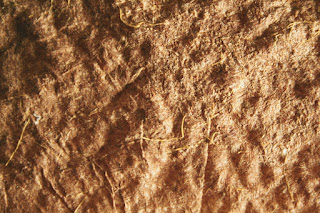June 19-20, 2010
A year ago, we began saving our onion skins in a glass jar with the intention of making paper from them one day. It was much delayed, but once we were unable to fit any more onion skins into the jar, the decision was made to make paper from them. It had been about a year since I had last made paper, and my ambition for doing so had admittedly taken a hit. Setting a goal to make paper out of this collection of onion skin turned out to be a great re-motivator, as making this batch of paper has reinvigorated my love of papermaking.
See the recipe and more images after the jump.
Materials:
¼ lb dry fiber
red onion skin, white onion skin, yellow onion skin, garlic skin
Process:
Prep:
soaked dry fiber in 3 quarts of water for 2 hours, 45 minutes
Cook:
heated 3 quarts water and added 1.5 tablespoons of soda ash just before boil
added fiber after soda ash dissolved
brought to a boil and reduced to low-medium heat
cooked fiber on low-medium for 40 minutes (until fiber could be easily pulled apart in the direction of growth)
let fiber rest in pot overnight to cool
Pulping:
beat fiber in a standard-size blender (5.5 cup capacity)
4 batches of fiber beat as follows
1 cup fiber, 4 cups water for 2 minutes
1 cup fiber, 4 cups water for 2 minutes
1 cup fiber, 4 cups water for 2 minutes
¼ cup fiber, 1 cup water for 2 minutes
Paper-Making:
pulled 7 sheets 10” x 10” of varying thicknesses
remaining pulp was bleached and added to a vat of pulp of a variety of recycled materials
pulled sheets were pressed under 60 lbs of weight for 2 hours
after pressing, sheets were laid to dry still on their felts
finished sheets dried to 7" x 7"
Thin, translucent yet stiff sheets, red/maroon in color due to presence of red onion skin in dry fiber.
Observations:
Pulp fibers are very short; similar to those of overbeaten fibers. Fibers have been colored, presumably by the presence of red onion skin.
Paper curled upon drying and the finished paper was quite thick.
Paper was also a darkish red/tan color.
Conclusions:
Completed paper sheets acted very similarly to overbeaten paper. If enough plant material could be gathered, onion skin paper pulled in this thickness would be an adequate replacement for overbeaten flax when desiring a paper for paper sculpture.
References:
Papermaking with Garden Plants and Common Weeds, Hiebert, Helen. Storey Publishing; 1998.
Papermaking with Garden Plants and Common Weeds, Hiebert, Helen. Storey Publishing; 1998.
Experience




Would love to see pictures
ReplyDeletewhat type of drying system do you use?
ReplyDelete